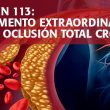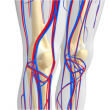The new ProEducar Educational Newsletter is out for all fellows, interventional trainees, and specialists in hemodynamics seeking to be up to date in their professional practice. This is a special issue on chronic total occlusion (CTO), one of the main current challenges for interventional cardiologists. This comprehensive, extensive work directed by Dr. Gustavo Pedernera includes...
Antianginal Medication Before and After Rechanneling
Escalation or de-escalation of antianginal medication was less common than treatment continuation without change after a chronic total occlusion rechanneling, with little variation according to the site. Further research is needed to identify patients who would benefit (or not) from these drugs and to develop strategies to adjust treatment during follow-up. This work basically tells...
The Most Read Scientific Articles in Interventional Cardiology
1- Long-Term Foramen Ovale Closure after Cryptogenic Stroke Patent foramen ovale closure is the standard treatment for cryptogenic stroke patients. However, there are is little information on its long-term evolution. Read more 2- Descending Thoracic Aortic Aneurysms: Is There a New Plan A? The last available evidence suggests that open surgery should be the...
Balancing Bleeding Risk vs. Thrombotic Risk to Define Dual Antiplatelet Therapy Duration
Patients who undergo complex angioplasty are at higher ischemic risk, but only benefit from extended dual antiplatelet therapy if there are no factors for high bleeding risk. These data suggest that the bleeding risk must weigh more than the ischemic risk on the determination of dual antiplatelet therapy duration. Complex angioplasty is associated with higher...
Surveillance after EVAR: When and How Long
It has been suggested that surveillance after endovascular abdominal aorta aneurysm repair (EVAR) should be for life, seeing as on one hand we are not sure how long these devices last (and they keep coming out), and on the other hand, there could be late complications, such as type 2 leaks. This is why the...
CTO: in Radial Access with Similar Results to Femoral
Courtesy of Dr. Carlos Fava. One of the characteristics of chronic total occlusion (CTO) is the use of two access routes: femoral and radial. The radial approach is safer, but it has not been thoroughly analyzed in this type of PCI. The study looked at 3709 patients undergoing left main percutaneous coronary intervention (PCI) for...
Is the Obesity Epidemic Putting Patients’ and Physicians’ Health at Risk?
Is the Obesity Epidemic Putting Patients’ and Physicians’ Health at Risk? In addition to the obvious negative effect on patients, obesity can also affect Interventional Cardiologists’ health, seeing as it involves increased exposure to radiation. Operators are clearly and increasingly exposed to radiation as patient body mass index (BMI) increases. Radiation exposure might be...
The Importance of Tibial Artery Patency in the Rechanneling of the Femoral Artery
After rechanneling occluded superficial femoro-popliteal arteries, interventional physicians are left with the question of how to proceed with infrapopliteal disease. This work (soon to be published in Eur J Vasc Endovasc Surg) shows us the importance of achieving patency in tibial arteries so as to obtain better mid-term outcomes. The gist is that, after an...
Clinical Improvement Without Ventricular Function Improvement After CTO
The benefits offered to patients by attempting the rechanneling of a chronic total occlusion are still unclear. Additionally, sometimes the procedural risks are somewhat undetermined. Taking into account these controversies, this work sought to prove whether successful rechanneling of a chronic total occlusion improves ventricular function. This is not a soft endpoint; it has been...
Practical Management of Coronary Perforations
Coronary perforation has an incidence of 0.5% and it is associated with a 13-fold increase in in-hospital events and a 5-fold increase in 30-day mortality. This event is so catastrophic that its management has become indispensable knowledge to all interventional cardiologists. This accident is most frequently provoked by artery over-dilation caused by a balloon or...









